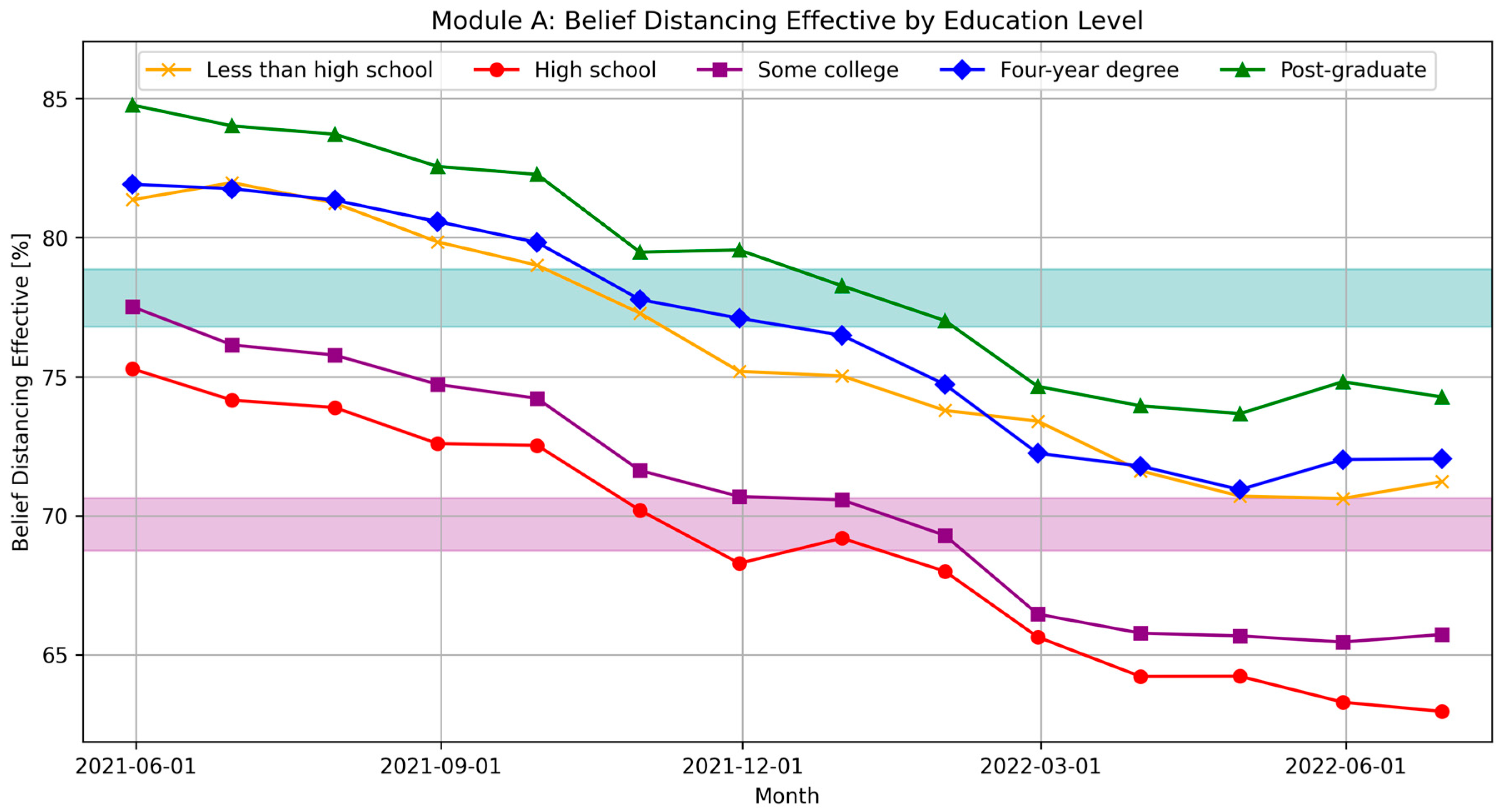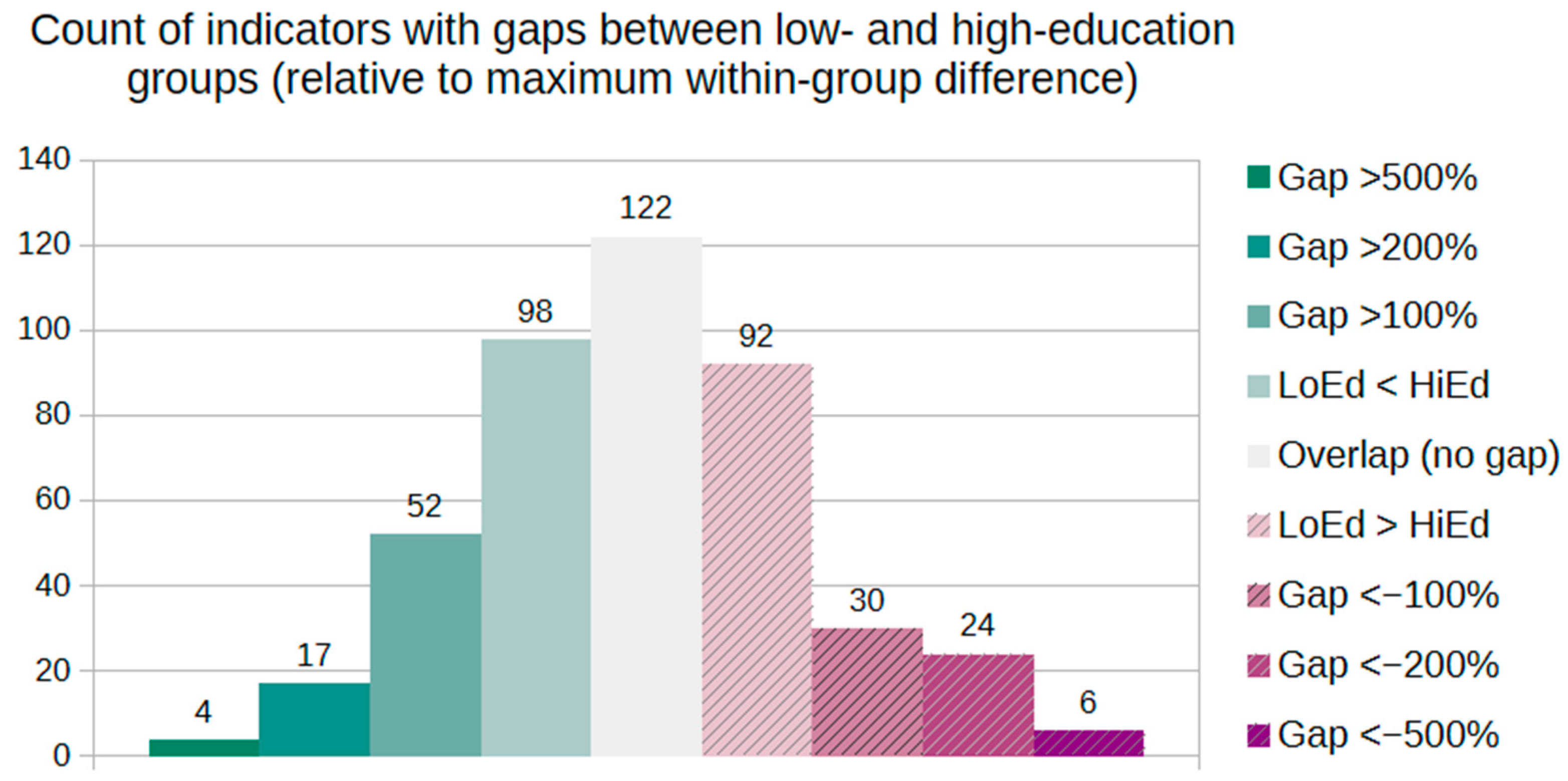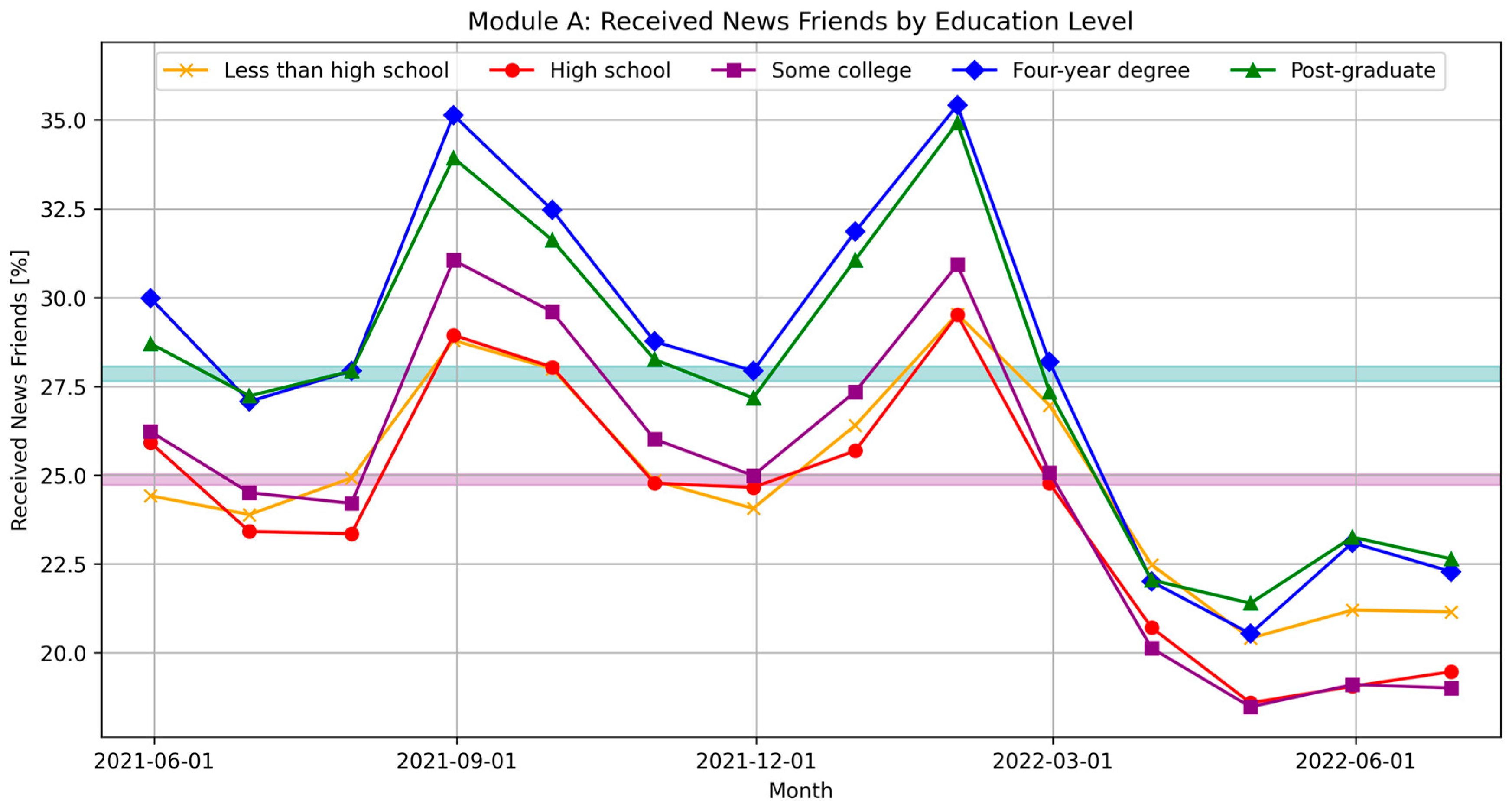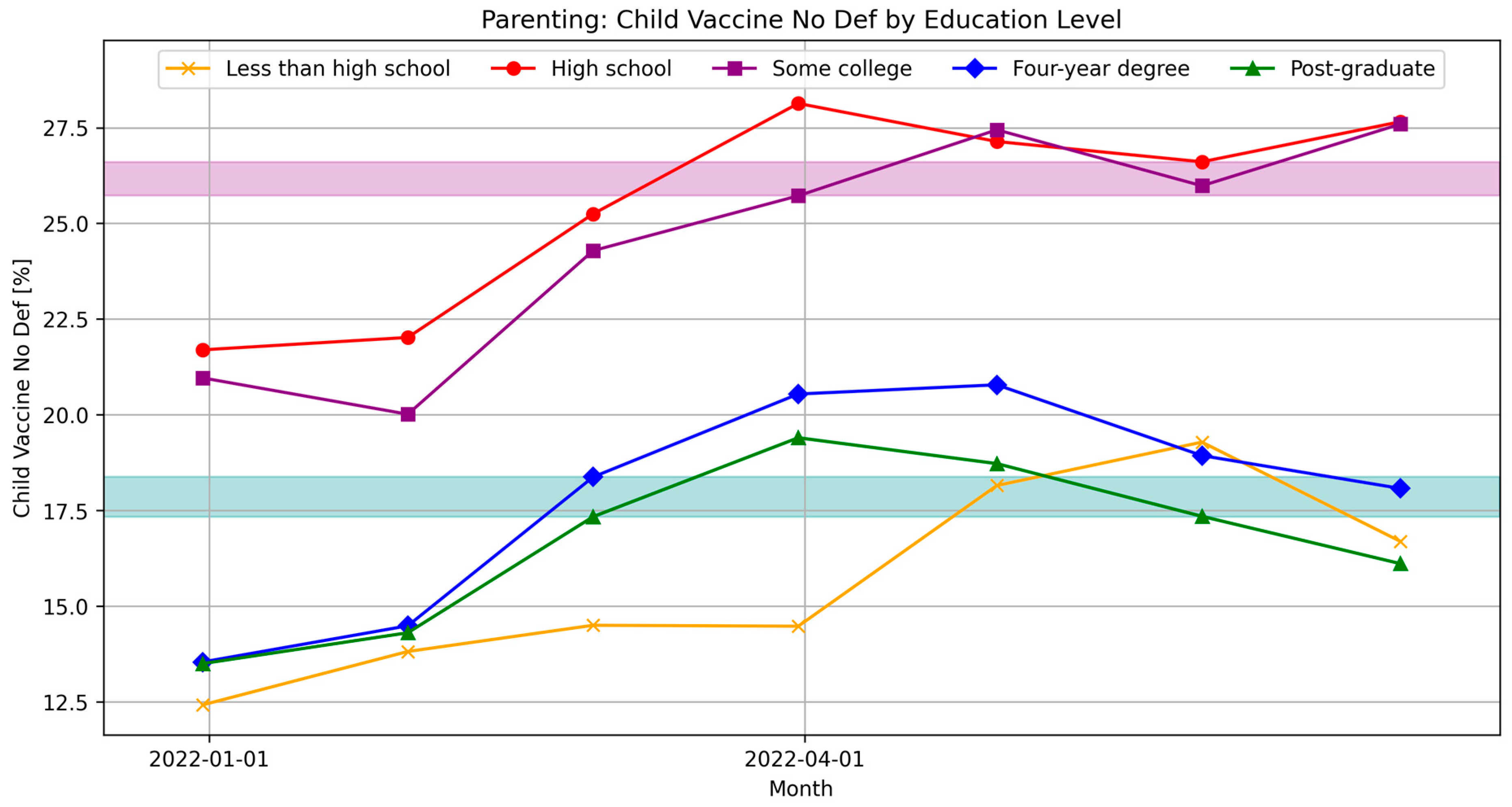The Class Gap in Pandemic Attitudes and Experiences
Abstract
1. Introduction
2. Materials and Methods
- Level 1: Less Than High School
- Level 2: High School
- Level 3: Some College
- Level 4: Four Year Degree
- Level 5: Post Graduate
- Group A: High School (Level 2) and Some College (Level 3)
- Group B: Four Year Degree (Level 4) and Post Graduate (Level 5)
3. Analysis and Results
3.1. Vaccine Hesitancy 2021–2022 by Level of Education
3.2. Belief in the Effectiveness of Distancing and Masking
3.3. Other COVID-19 Attitudes and Experiences
4. Discussion
5. Conclusions
Funding
Institutional Review Board Statement
Informed Consent Statement
Data Availability Statement
Acknowledgments
Conflicts of Interest
References
- Martin, R. Human behaviors during the COVID-19 pandemic and their consequences. Int. J. Popul. Stud. 2025, 11, 1–30. [Google Scholar] [CrossRef]
- Chaufan, C.; Heredia, C.; McDonald, J.; Hemsing, N. The balance of risks and benefits in the COVID-19 “Vaccine hesitancy” literature: A critical umbrella review. J. Res. Appl. Med. 2023, 2, 9. [Google Scholar]
- UnHerd. The Most Vaccine-Hesitant Group of All? PhDs. 2021. Available online: https://unherd.com/newsroom/the-most-vaccine-hesitant-education-group-of-all-phds/ (accessed on 20 March 2025).
- King, W.C.; Rubinstein, M.; Reinhart, A.; Mejia, R.J. Time Trends and Factors Related to COVID-19 Vaccine Hesitancy from January–May 2021 Among US Adults: Findings from a Large-Scale National Survey. medRxiv 2021. preprint. Available online: https://www.medrxiv.org/content/10.1101/2021.07.20.21260795v1 (accessed on 9 September 2023).
- Salomon, J.A.; Reinhart, A.; Bilinski, A.; Chua, E.J.; La Motte-Kerr, W.; Rönn, M.M.; Reitsma, M.B.; Morris, K.A.; LaRocca, S.; Farag, T.H.; et al. The US COVID-19 Trends and Impact Survey: Continuous real-time measurement of COVID-19 symptoms, risks, protective behaviors, testing, and vaccination. Proc. Natl. Acad. Sci. USA 2021, 118, e2111454118. [Google Scholar] [CrossRef] [PubMed]
- Thaler, S. Americans with PhDs Are Most Reluctant to Get Vaccinated Against COVID. 2021. Available online: https://www.dailymail.co.uk/news/article-9893465/Americans-PhDs-reluctant-vaccinated-against-COVID-study-finds.html (accessed on 20 March 2025).
- King, W.C.; Rubinstein, M.; Reinhart, A.; Mejia, R. Time trends, factors associated with, and reasons for COVID-19 vaccine hesitancy: A massive online survey of US adults from January–May 2021. PLoS ONE 2021, 16, e0260731. [Google Scholar] [CrossRef] [PubMed]
- Soorapanth, S.; Cheung, R.; Zhang, X.; Mokdad, A.H.; Mensah, G.A. Rural–Urban Differences in Vaccination and Hesitancy Rates and Trust: US COVID-19 Trends and Impact Survey on a Social Media Platform, May 2021–April 2022. Am. J. Public Health 2023, 113, 680–688. [Google Scholar] [CrossRef]
- Yang, Y.; Dempsey, W.; Han, P.; Deshmukh, Y.; Richardson, S.; Tom, B.; Mukherjee, B. Exploring the Big Data Paradox for various estimands using vaccination data from the global COVID-19 Trends and Impact Survey (CTIS). Sci. Adv. 2024, 10, eadj0266. [Google Scholar] [CrossRef]
- Cox-Ganser, J.M.; Henneberger, P.K.; Weissman, D.N.; Guthrie, G.; Groth, C.P. COVID-19 test positivity by occupation using the Delphi US COVID-19 trends and impact survey, September–November 2020. Am. J. Ind. Med. 2022, 65, 721–730. [Google Scholar] [CrossRef]
- Nguyen, Q.C.; Yardi, I.; Gutierrez, F.X.M.; Mane, H.; Yue, X. Leveraging 13 million responses to the U.S. COVID-19 Trends and Impact Survey to examine vaccine hesitancy, vaccination, and mask wearing, January 2021–February 2022. BMC Public Health 2022, 22, 1911. [Google Scholar] [CrossRef]
- Ettman, C.K.; Badillo-Goicoechea, E.; Stuart, E.A. Evolution of Depression and Anxiety During the COVID-19 Pandemic and Across Demographic Groups in a Large Sample of U.S. Adults. AJPM Focus 2023, 2, 100140. [Google Scholar] [CrossRef] [PubMed]
- Rufino, J.; Baquero, C.; Frey, D.; Glorioso, C.A.; Ortega, A.; Reščič, N.; Roberts, J.C.; Lillo, R.E.; Menezes, R.; Champati, J.P.; et al. Using survey data to estimate the impact of the omicron variant on vaccine efficacy against COVID-19 infection. Sci. Rep. 2023, 13, 900. [Google Scholar] [CrossRef]
- Huang, C.; Smith, R.L. A modeling study on SARS-CoV-2 transmissions in primary and middle schools in Illinois. BMC Public Health 2024, 24, 3197. [Google Scholar] [CrossRef] [PubMed]
- Aw, J.; Seng, J.J.B.; Seah, S.S.Y.; Low, L.L. COVID-19 Vaccine Hesitancy—A Scoping Review of Literature in High-Income Countries. Vaccines 2021, 9, 900. [Google Scholar] [CrossRef]
- AlShurman, B.A.; Khan, A.F.; Mac, C.; Majeed, M.; Butt, Z.A. What Demographic, Social, and Contextual Factors Influence the Intention to Use COVID-19 Vaccines: A Scoping Review. Int. J. Environ. Res. Public Health 2021, 18, 9342. [Google Scholar] [CrossRef] [PubMed]
- Green, J.; Fischer, E.F.; Fitzgerald, D.; Harvey, T.S.; Thomas, F. The publics of public health: Learning from COVID-19. Crit. Public Health 2022, 32, 592–599. [Google Scholar] [CrossRef]
- Allen, D. Why Did Jurisdictions Repeatedly Use Inefficient Lockdowns During the COVID-19 Pandemic? Policy Commons. 2023. Available online: https://policycommons.net/artifacts/3376877/why-did-jurisdictions-repeatedly-use-inefficient-lockdowns-during-the-covid-19-pandemic/4175762/ (accessed on 20 March 2025).
- Tierney, J. The Panic Pandemic. City Journal. 2021. Available online: https://www.city-journal.org/article/the-panic-pandemic (accessed on 20 March 2025).
- Roy, M.; Gandsman, A. Polarizing figures of resistance during epidemics. A comparative frame analysis of the COVID-19 freedom convoy. Crit. Public Health 2023, 33, 788–802. [Google Scholar] [CrossRef]
- Graeber, D. Anthropology and the rise of the professional-managerial class. HAU J. Ethnogr. Theory 2014, 4, 73–88. [Google Scholar] [CrossRef]
- Liu, C. Virtue Hoarders: The Case Against the Professional Managerial Class; Forerunners: Ideas First; University of Minnesota Press: Minneapolis, MN, USA, 2021; 90p, Available online: https://www.upress.umn.edu/9781517912253/virtue-hoarders/ (accessed on 20 March 2025).
- Clerval, A. Displacement: Cause and consequence of gentrification. Urban Geogr. 2021, 42, 1054–1057. [Google Scholar] [CrossRef]
- Reinhart, A.; Mejia, R.; Tibshirani, R.J. COVID-19 Trends and Impact Survey (CTIS), United States, 2020–2022; Inter-University Consortium for Political and Social Research: Ann Arbor, MI, USA, 2025; Available online: https://www.icpsr.umich.edu/web/ICPSR/studies/39207/versions/V1 (accessed on 20 March 2025).
- CTIS. Contingency Tables | Delphi Epidata API. 2020. Available online: https://web.archive.org/web/20250207013308/https://cmu-delphi.github.io/delphi-epidata/symptom-survey/contingency-tables.html (accessed on 20 March 2025).
- Bleier, B.S.; Ramanathan, M., Jr.; Lane, A.P. COVID-19 Vaccines May Not Prevent Nasal SARS-CoV-2 Infection and Asymptomatic Transmission. Otolaryngol. Head Neck Surg. 2021, 164, 305–307. [Google Scholar] [CrossRef]
- Gupta, R.K.; Topol, E.J. COVID-19 vaccine breakthrough infections. Science 2021, 374, 1561–1562. [Google Scholar] [CrossRef]
- Doshi, P. Will covid-19 vaccines save lives? Current trials aren’t designed to tell us. BMJ 2020, 371, m4037. [Google Scholar] [CrossRef]
- Jefferson, T.; Dooley, L.; Ferroni, E.; Al-Ansary, L.A.; Driel, M.L.; Bawazeer, G.A.; Jones, M.A.; Hoffmann, T.C.; Clark, J.; Beller, E.M.; et al. Physical interventions to interrupt or reduce the spread of respiratory viruses. Cochrane Database Syst. Rev. 2023, 1, CD006207. [Google Scholar] [CrossRef] [PubMed]
- Kisielinski, K.; Hockertz, S.; Hirsch, O.; Korupp, S.; Klosterhalfen, B.; Schnepf, A.; Dyker, G. Wearing face masks as a potential source for inhalation and oral uptake of inanimate toxins—A scoping review. Ecotoxicol. Environ. Saf. 2024, 275, 115858. [Google Scholar] [CrossRef] [PubMed]
- Schippers, M.C. For the Greater Good? The Devastating Ripple Effects of the COVID-19 Crisis. Front. Psychol. 2020, 11, 577740. [Google Scholar] [CrossRef]
- Joffe, A.R.; Redman, D. The SARS-CoV-2 Pandemic in High Income Countries Such as Canada: A Better Way Forward Without Lockdowns. Front. Public Health 2021, 9, 715904. [Google Scholar] [CrossRef]
- Allen, D.W. COVID-19 Lockdown Cost/Benefits: A Critical Assessment of the Literature. Int. J. Econ. Bus. 2022, 29, 1–32. [Google Scholar] [CrossRef]
- Simandan, D.; Rinner, C.; Capurri, V. The academic left, human geography, and the rise of authoritarianism during the COVID-19 pandemic. Geogr. Ann. Ser. B Hum. Geogr. 2023, 106, 175–195. [Google Scholar] [CrossRef]
- Joffe, A.R.; Kazemi, P.; Mdcm, R.E.; Milburn, C. When COVID-19 Claims of ‘Revisionism’ and ‘Misinformation’ Are Themselves Misinformed; The Frontier Centre for Public Policy (FCPP): Winnipeg, MB, Canada, 2025; Report No. 144; Available online: https://fcpp.org/2025/02/12/when-covid-19-claims-of-revisionism-and-misinformation-are-themselves-misinformed/ (accessed on 21 November 2025).
- Deary, I.J.; Johnson, W. Intelligence and education: Causal perceptions drive analytic processes and therefore conclusions. Int. J. Epidemiol. 2010, 39, 1362–1369. [Google Scholar] [CrossRef]
- Ritchie, S.J.; Tucker-Drob, E.M. How Much Does Education Improve Intelligence? A Meta-Analysis. Psychol. Sci. 2018, 29, 1358–1369. [Google Scholar] [CrossRef]
- Caplan, B. The Case Against Education: Why the Education System Is a Waste of Time and Money; Princeton University Press: Princeton, NJ, USA, 2019; 424p, Available online: https://www.torrossa.com/en/resources/an/5563590 (accessed on 20 November 2025).
- Goldberg, Y.; Mandel, M.; Bar-On, Y.M.; Bodenheimer, O.; Freedman, L.; Haas, E.J.; Milo, R.; Alroy-Preis, S.; Ash, N.; Huppert, A. Waning Immunity after the BNT162b2 Vaccine in Israel. N. Engl. J. Med. 2021, 385, e85. [Google Scholar] [CrossRef]
- Prugger, C.; Spelsberg, A.; Keil, U.; Erviti, J.; Doshi, P. Evaluating COVID-19 vaccine efficacy and safety in the post-authorisation phase. BMJ 2021, 375, e067570. [Google Scholar] [CrossRef]
- Fraiman, J.; Erviti, J.; Jones, M.; Greenland, S.; Whelan, P.; Kaplan, R.M.; Doshi, P. Serious adverse events of special interest following mRNA COVID-19 vaccination in randomized trials in adults. Vaccine 2022, 40, 5798–5805. [Google Scholar] [CrossRef]
- Guetzkow, J.A.; Levi, R. Effect of mRNA Vaccine Manufacturing Processes on Efficacy and Safety Still an Open Question. BMJ 2022, 378, o1731. Available online: https://www.bmj.com/content/378/bmj.o1731/rr-2 (accessed on 9 October 2023).
- Kämmerer, U.; Schulz, V.; Steger, K. BioNTech RNA-Based COVID-19 Injections Contain Large Amounts of Residual DNA Including an SV40 Promoter/Enhancer Sequence. Sci. Public Health Policy Law 2024, 5, 2019–2024. [Google Scholar]
- Chaufan, C. Is COVID-19 “vaccine uptake” in postsecondary education a “problem”? A critical policy inquiry. Health 2024, 28, 831–857. [Google Scholar] [CrossRef]
- Chaufan, C.; Hemsing, N.; Moncrieffe, R. “It isn’t about health, and it sure doesn’t care”: A qualitative exploration of healthcare workers’ lived experience of the policy of vaccination mandates in Ontario, Canada. J. Public Health Emerg. 2025, 9, 16. [Google Scholar] [CrossRef]
- Junger, N.; Hirsch, O. Ethics of Nudging in the COVID-19 Crisis and the Necessary Return to the Principles of Shared Decision Making: A Critical Review. Cureus 2024, 16, e57960. [Google Scholar] [CrossRef] [PubMed]
- Bradley, V.C.; Kuriwaki, S.; Isakov, M.; Sejdinovic, D.; Meng, X.L.; Flaxman, S. Unrepresentative big surveys significantly overestimated US vaccine uptake. Nature 2021, 600, 695–700. [Google Scholar] [CrossRef] [PubMed]
- Dixon, M. What’s in a Name?: A Critical Review of Barbara and John Ehrenreich’s “Professional-Managerial Class”. Synthesis 1978, 2, 68–89. [Google Scholar]
- Joffe, A.R. COVID-19: Rethinking the Lockdown Groupthink. Front. Public Health 2021, 9, 625778. [Google Scholar] [CrossRef] [PubMed]
- Monaghan, L.F. Schematising COVID-19 pandemic responses: An ideal typical analysis. Soc. Sci. Med. 2024, 349, 116872. [Google Scholar] [CrossRef] [PubMed]












Disclaimer/Publisher’s Note: The statements, opinions and data contained in all publications are solely those of the individual author(s) and contributor(s) and not of MDPI and/or the editor(s). MDPI and/or the editor(s) disclaim responsibility for any injury to people or property resulting from any ideas, methods, instructions or products referred to in the content. |
© 2025 by the author. Licensee MDPI, Basel, Switzerland. This article is an open access article distributed under the terms and conditions of the Creative Commons Attribution (CC BY) license (https://creativecommons.org/licenses/by/4.0/).
Share and Cite
Rinner, C. The Class Gap in Pandemic Attitudes and Experiences. COVID 2025, 5, 195. https://doi.org/10.3390/covid5120195
Rinner C. The Class Gap in Pandemic Attitudes and Experiences. COVID. 2025; 5(12):195. https://doi.org/10.3390/covid5120195
Chicago/Turabian StyleRinner, Claus. 2025. "The Class Gap in Pandemic Attitudes and Experiences" COVID 5, no. 12: 195. https://doi.org/10.3390/covid5120195
APA StyleRinner, C. (2025). The Class Gap in Pandemic Attitudes and Experiences. COVID, 5(12), 195. https://doi.org/10.3390/covid5120195





